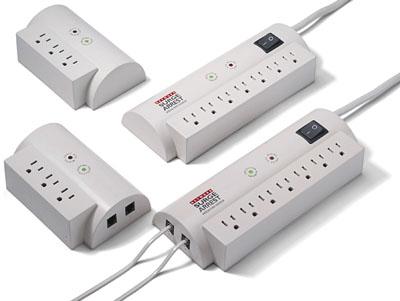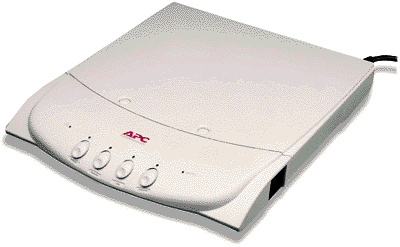[ The PC Guide | Systems and Components Reference Guide | Power | External Power | Protection Against Power Problems ]
Surge Suppressors and Power Stations
Few people are willing to use their PCs with no protection at all. The least-expensive, most basic form of protection is a surge suppressor. These devices take the form of a plastic block with outlets into which you plug in your computer, monitor and other devices, with a cord which then plugs into the wall. These are also sometimes called "power strips" or "power bars". Surge protectors range in quality from very good to almost useless, with the protection being somewhat proportional to the cost. Cheap surge suppressors don't really offer very much protection. Some protection is better than nothing, but don't fool yourself into thinking a $5 surge suppressor is going to do very much to prevent power problems on your PC.
|
A collection of different surge suppressors. Note some
of the features |
Image � American
Power Conversion Corp. |
Surge suppressors normally work to reduce power problems in two ways. First, they use power absorbing components that take the shock of voltage spikes and surges and prevent them from being passed on to your computer equipment. The usual component that is used for this purpose is called a metal-oxide varistor or MOV. These devices are designed so that any voltage above a specified "safe" level is shunted to ground instead of being passed through. This is what is protecting your equipment, though they only work up to a point--a metal-oxide varistor is not likely to handle a lightning strike. Second, they normally include some line conditioning circuitry to smooth out and reduce power line noise, although not the top of the line components that you'd find in a true line conditioner.
There are several quality and feature considerations that you should take into account when shopping for a surge suppressor. As you do, bear in mind that the marketing droids are at work in the power protection industry as readily as they are elsewhere, and if you see a power strip that claims to provide "ultimate protection" but costs as much as a Happy Meal, be wary. Here are some specifications and quality considerations to consider:
- Energy Absorption: Surge suppressors are normally rated by the amount of energy they can absorb, which is measured in joules. The higher the surge rating of the suppressor--assuming the company's claims are believable--the better the unit. Generally, 200 joules is basic protection, 400 is good protection and 600 or higher is superior protection.
- UL Standards for Voltage Let-Through: Underwriters Laboratories is the foremost standards testing lab in the United States, and has established standard UL 1449 for surge suppressors. This standard rates suppressors by the amount of voltage they allow to pass through to protected equipment. To test the units, they are subjected to a 500 A, 6000 V surge and the output measured to see what voltage level is let through to the equipment. There are three levels of rated protection: 330 V, 400 V and 500 V. Obviously, the lower the number, the better. Note that even the 330 V number is triple the nominal voltage of a North American PC power supply!
- Protection Indicator: Metal-oxide varistors do not last forever. If they are subjected to many surges over time, or perhaps one very large one, they can blow. If this happens, your surge suppressor is no longer protecting your equipment from voltage problems. But how do you know when this happens? On older units (and still on cheaper units) you really don't know. On good units today though, an LED is provided that indicates if the MOVs are working or not. This is an important feature to look for.
- Line Conditioning: Surge suppressors normally contain some line conditioning capabilities as well. This subject is discussed in the section on line conditioners. When you buy a suppressor, read the box carefully. Not all surge suppressors condition the line.
- Power Switch: Some suppressors have a manual on/off switch, while others do not. Some suppressors have a mix between switched and unswitched circuits, which means some of them are turned on and off by the switch while others are always powered on whenever the unit is plugged in. This can be a useful feature. For example, you can keep a battery charger for a laptop, or an electric clock running, while shutting off other components with the switch.
- Circuit Breaker or Fuse: Most suppressors will have either a fuse or a resettable circuit breaker, which will blow or trip if there is a short circuit or severe surge that causes excessive current to flow. Breakers are better because fuses, once blown, have to be replaced.
- Protection Guarantee: Many companies provide an equipment protection guarantee, which says that if your equipment is damaged when plugged into their suppressors, they will pay to have it repaired or replaced. Make sure you read carefully the terms and conditions of any such guarantees before you count on them!
![]() Warning: You should always
remember to use your operating system's correct shut down procedure before powering off
your main PC box. If you are in the middle of using Windows and just "hit the
switch", you risk lost data and file system corruption.
Warning: You should always
remember to use your operating system's correct shut down procedure before powering off
your main PC box. If you are in the middle of using Windows and just "hit the
switch", you risk lost data and file system corruption.
![]() Note: Some suppressors have
a light that is just a "power on" light. All that shows is that the power is
flowing. This obviously provides no indication at all of your protection level, but it
does tell you if the suppressor is plugged in and working (at least at a basic level).
This should not be confused with the protection indicator LED mentioned above.
Note: Some suppressors have
a light that is just a "power on" light. All that shows is that the power is
flowing. This obviously provides no indication at all of your protection level, but it
does tell you if the suppressor is plugged in and working (at least at a basic level).
This should not be confused with the protection indicator LED mentioned above.
A variant on the surge suppressor theme is the power station, also called a power manager. This is a unit that also provides numerous outlets for your equipment to plug into, but adds buttons to allow you to easily turn on and off individual units. They are often shaped to allow them to sit under your PC's monitor. Some of these units, such as the one pictured below, include full surge suppressor capabilities. Others have the on/off buttons and little else, and do almost nothing to protect your equipment! Be sure of what you are buying.
|
An APC power station / power manager. |
Image � American
Power Conversion Corp. |
![]() Warning: I have received
information that warns about possible equipment failure and even safety hazards as a
result of plugging surge suppressors into the output jacks of a UPS.
You should never do this, as it could create a hazardous situation.
Warning: I have received
information that warns about possible equipment failure and even safety hazards as a
result of plugging surge suppressors into the output jacks of a UPS.
You should never do this, as it could create a hazardous situation.
![]() Next: Line Conditioners
Next: Line Conditioners
| The PC Guide
(http://www.PCGuide.com) Site Version: 2.2.0 - Version Date: April 17, 2001 © Copyright 1997-2004 Charles M. Kozierok. All Rights Reserved. |
Not responsible for any loss resulting from the use of this site. Please read the Site Guide before using this material. |

